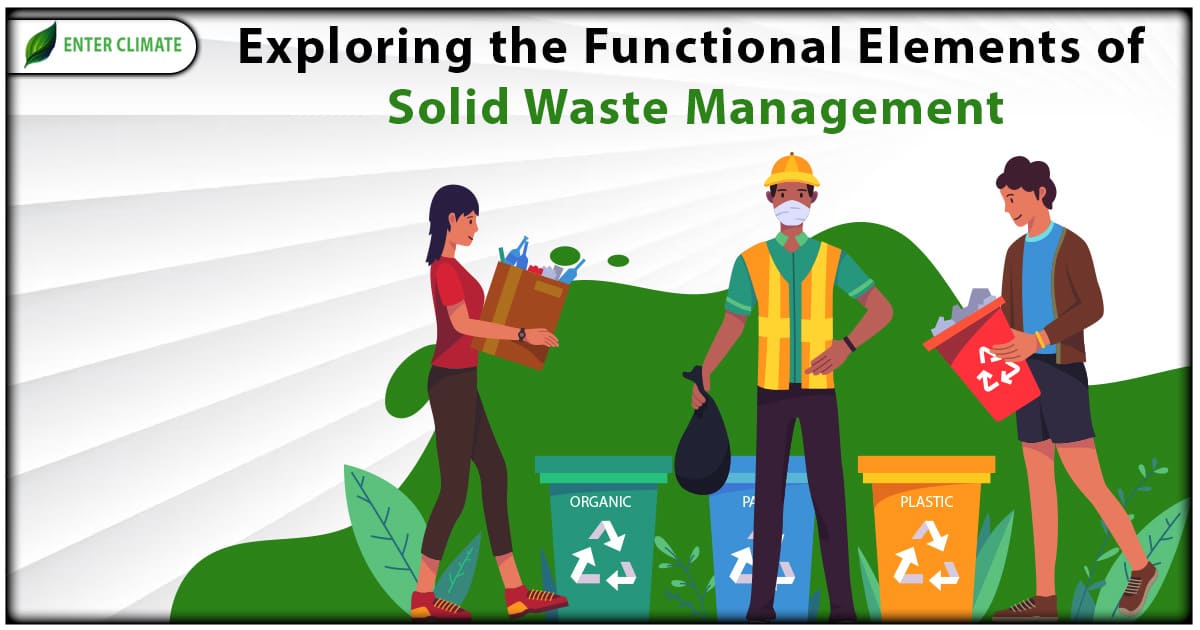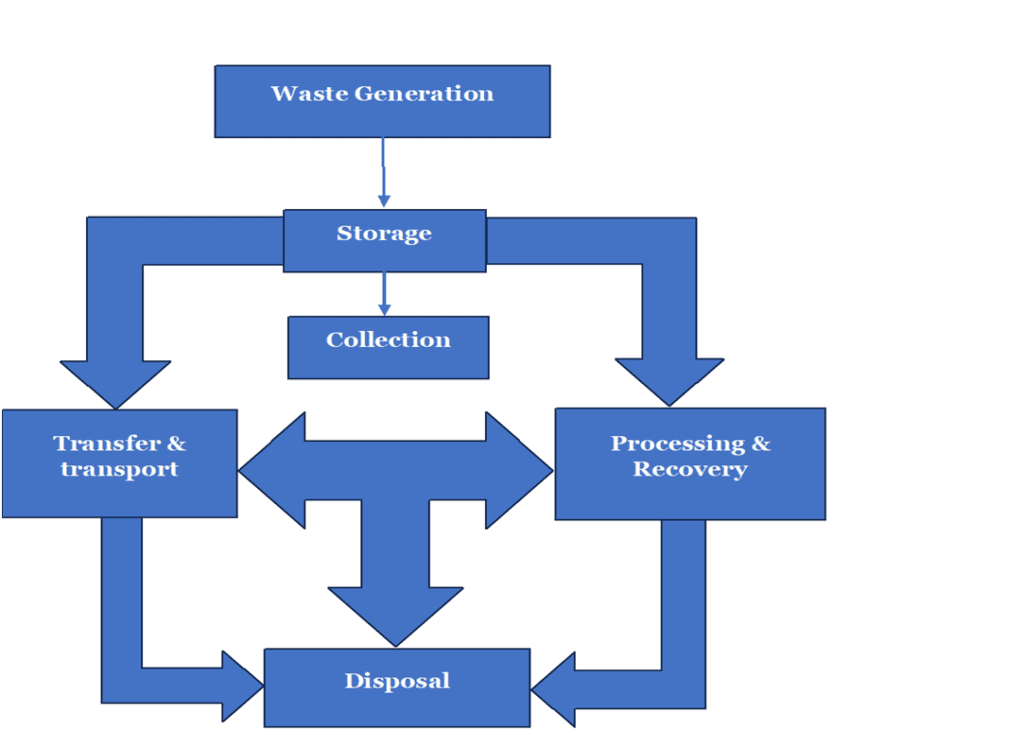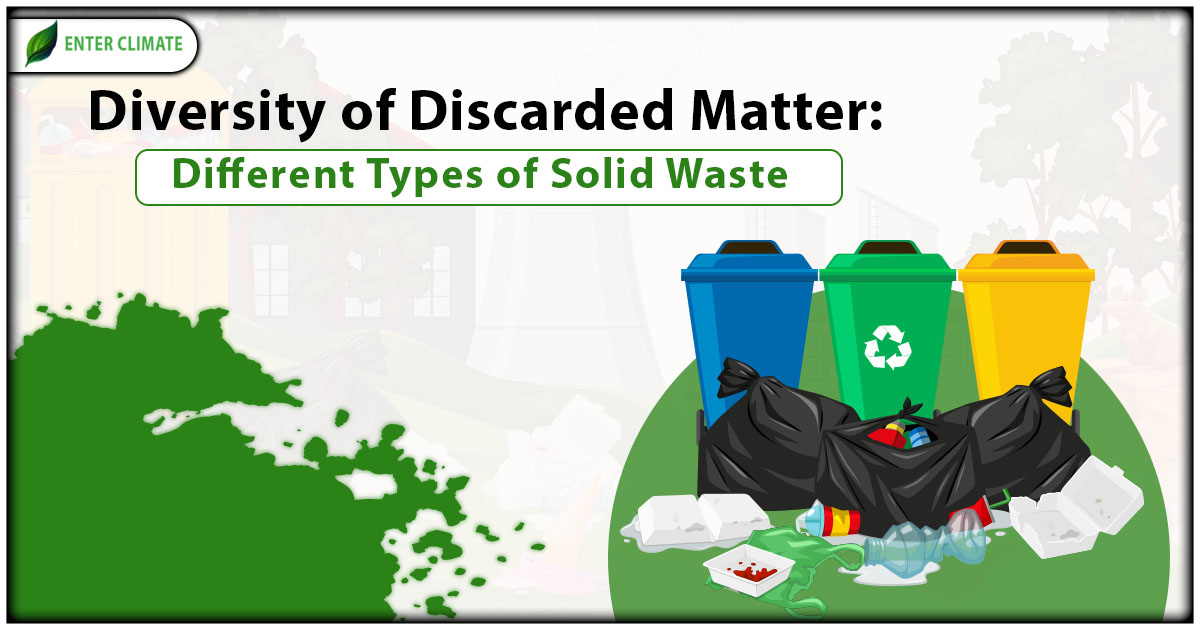Exploring the Functional Elements of Solid Waste Management
 04 Aug, 2023
04 Aug, 2023 
Elements of Solid Waste Management involve a combination of functional elements dedicated to the efficient management of solid wastes. Its implementation facilitates cost-effective collection and disposal of solid wastes within communities while prioritizing public health and minimizing adverse environmental impacts. SWM encompasses various stages, including waste generation control, proper storage, systematic collection, efficient transfer and transport, effective processing, and responsible disposal. These stages adhere to principles of public health, economics, engineering, conservation, aesthetics, public attitudes, and environmental considerations. Additionally, modern waste management emphasizes the importance of “Reduce, Reuse and Recycle” practices to move beyond mere waste disposal and promote sustainable and eco-friendly waste handling.
Functional Elements of Solid Waste Management
There are six Elements of Solid Waste Management:
- Solid waste generation
- On-site handling and storage
- Collection
- Transfer and transport
- Material and resource recovery
- Disposal
Solid Waste Generation
In Elements of Solid Waste Management, Solid waste generation pertains to the production of waste materials through various activities in residential, commercial, and industrial settings. Understanding the components of Solid Waste Management is essential to formulate appropriate waste management strategies. The estimation of waste generation rates can be achieved using the formula: Waste Generation = Population × Per Capita Waste Generation Rate. Solid waste generation results from natural, human, and animal activities. Knowing waste generation is vital in planning, designing, and operating solid waste management systems. This process encompasses two aspects: the quality of solid waste, including its sources, types, typical composition, and properties, as well as the quantity of solid waste, which involves generation rates and total quantities and volumes of waste produced.Proper handling, storage, and separation of solid waste at the source before collection are crucial steps in the effective management of residential solid waste.
Waste Handling
Handling refers to the various tasks associated with the management of solid wastes, starting from their initial handling until they are placed in containers designated for storage before collection or transport to drop-off and recycling centres. The specific activities involved in handling waste at the source of generation will depend on the types of waste materials being separated for reuse and recycling, as well as the level of separation from the general waste stream. Depending on the collection service the handling may also involve moving the filled containers to the collection point and returning the empty containers to their storage location between collections. On-site handling and storage encompass the appropriate containment and temporary storage of waste materials at their point of origin. This process includes tasks like waste segregation, waste minimization efforts, and the use of suitable containers or bins. For instance, households may employ separate bins for recyclable materials and non-recyclable waste. By conducting on-site storage, waste is effectively managed until it is collected, ensuring proper waste disposal practices.
Waste Storage
The initial step in solid waste management takes place at the household level, where temporary storage of refuse occurs on the premises. It becomes the responsibility of individual households or businesses to manage the on-site storage of solid waste properly. For both residential homes and commercial establishments, ensuring appropriate on-site storage of solid waste marks the first crucial stage of proper waste disposal. Neglected solid waste or haphazard dumps can give rise to nuisances, attract flies, produce odours, and create various hazards. Hence, focusing on proper on-site storage becomes essential to avoid these issues and initiate effective waste management practices.
Collection
The term “collection” encompasses more than just the act of gathering or picking up solid wastes from different origins; it also involves the transportation of these wastes to disposal sites or transfer stations and the unloading process there. Although hauling and unloading are generally similar across various collection systems, the specific methods of waste collection or pickup may vary depending on the facilities and locations. The collection entails the systematic gathering and transportation of waste from diverse sources to a central location or transfer station. The design of efficient collection systems considers factors such as population density, waste generation rates, and transportation logistics. Various collection methods are employed, including curbside collection, door-to-door collection, and community drop-off points. Garbage trucks and other collection vehicles are used to transport the waste to the subsequent stage.
Transfer and Transport
Transfer and transport pertain to the methods, facilities, and equipment employed to facilitate the movement of wastes from one location to another, often to a more distant site. In this process, waste from smaller collection vehicles is typically transferred to larger vehicles, which then transport it to remote locations. The transfer and transport activities involve the movement of waste from the initial collection points or transfer stations to treatment or disposal facilities. During this process, waste transfer stations serve as intermediate hubs where waste is consolidated from smaller collection vehicles into larger transport vehicles. To ensure proper handling and containment, appropriate transport equipment is crucial in preventing spillage, littering, and the generation of unpleasant odours during transfer and transport operations.
Resource Recovery and Processing
Resource recovery involves a partial solid waste disposal and reclamation process, aiming to achieve reductions in future landfill volume requirements. To effectively implement resource recovery, it is essential to identify valuable materials worth recovering and acknowledge the environmental benefits associated with the process.
Material and resource recovery focuses on extracting value from waste through recycling, composting, or energy recovery methods. These processes play a crucial role in reducing the overall volume of waste sent to disposal facilities and contribute to the conservation of natural resources. Specific examples of material and resource recovery include:
- Recycling: The separation and processing of recyclable materials, such as paper, plastic, metal, and glass, to facilitate their remanufacturing into new products.
- Composting: The decomposition of organic waste materials, such as food scraps and yard waste, leading to the production of nutrient-rich compost used for soil amendment.
- Energy Recovery: The utilization of waste as a fuel source through various processes like waste-to-energy (WTE) or anaerobic digestion, thereby generating electricity or heat.
Disposal
After segregation, much of the organic content can undergo bacterial decomposition, resulting in a product known as humus or compost. This entire process, involving both separation and bacterial conversion, is commonly referred to as “Composting”[1]. The decomposition of solid waste can be carried out either aerobically or anaerobically. Disposal marks the final stage of solid waste management, where waste that cannot be recovered or recycled is handled safely and responsibly. Common disposal methods include landfilling and incineration.
- Landfilling: Waste is carefully deposited in specially engineered landfills, where it undergoes controlled decomposition over time. To minimize environmental impacts, landfills are designed with liners, leachate collection systems, and gas management infrastructure.
- Incineration: Waste is subjected to high temperatures in waste-to-energy facilities, reducing its volume and generating electricity or heat. Modern incineration plants are equipped with air pollution control technologies to minimize emissions.

Documents required for Authorization of Solid Waste Management
In the context of the Elements of Solid Waste Management, certain essential documents play a vital role in ensuring the proper and legal functioning of waste management processes. These documents are necessary to establish the legitimacy and compliance of the waste management entity with various regulations and guidelines.
- Authorized Signatory Aadhar Card: This document serves as proof of identity for the authorized signatory, who holds the responsibility to represent the waste management entity in official matters.
- PAN Card of the Authorized Signatory: The PAN card is essential for tax purposes and serves as an identification for the authorized signatory concerning financial matters related to waste management operations.
- GST Certificate: The Goods and Services Tax (GST) certificate is required for entities involved in waste management services, ensuring compliance with the taxation regulations.
- Proof of Ownership of Site or Rent/Lease Agreement: This document verifies the ownership or tenancy of the site where waste management activities are conducted. It ensures that the waste management entity has the legal right to operate on the premises.
- Factory License/Trade License: The factory or trade license is necessary to validate that the waste management facility is operating within the legal framework and holds the appropriate permits to carry out its activities.
- Electricity Bill: The electricity bill serves as evidence of the operational status of the waste management facility, indicating that it has a functional electricity supply for its operations.
- Layout Plan: The layout plan illustrates the spatial organization of the waste management facility, highlighting key areas such as waste collection, processing, and disposal zones.
- Process Flow Chart: This document outlines the step-by-step processes involved in waste management operations, providing a clear understanding of how waste is handled and managed.
- Details of the Machinery Installed: This information includes a comprehensive list of the machinery and equipment used in waste management operations, ensuring that the facility has the necessary tools to handle waste effectively.
Conclusion
The Elements of Solid Waste Management form a crucial framework for the effective and sustainable handling of waste materials. From waste generation to proper disposal, each element plays a significant role in reducing the environmental impact, preserving public health, and conserving valuable resources. Through proper waste segregation, collection, transfer, and transport, as well as resource recovery through recycling and composting, waste management practices aim to minimize the volume of waste sent to incinerators and landfills. It is recommended to take expert advice to ensure the compliances of licenses and documents that would be required for your Authorization of Solid Waste Management of the Elements of Solid Waste Management.
FAQs
The E-Waste (Management) Second Amendment Rules, 2023, have been officially announced by the Central Government. The primary objective of these rules is to establish a secure, responsible, and sustainable framework for managing e-waste. Special attention is given to addressing the handling of refrigerants generated during the production and end-of-life stages of refrigeration and air-conditioning equipment.
The six essential functional elements, listed sequentially, include waste generation, onsite handling and storage, waste collection, waste transfer, waste processing, and disposal.
The objective is to offer sanitary, effective, and cost-effective methods for storing, collecting, transporting, treating, or disposing of solid waste without causing pollution to the air, soil, or water systems.
The aim is to ensure clean, effective, and cost-efficient solid waste storage, collection, transportation, treatment, or disposal methods, while also safeguarding the environment from air, soil, or water pollution.
Properly managing the handling, storage, and segregation of solid waste at its origin is a crucial stage in the effective management of residential solid waste.
Source reduction and reuse, recycling or composting, energy recovery, and treatment and disposal are the four key approaches in waste management.
The five principles known as the 5 R’s are: Refuse, Reduce, Reuse, Repurpose, and Recycle.
The seven categories of solid waste consist of Residential, Industrial, Commercial, Institutional, Construction and Demolition, Municipal Services, Treatment Plants and Sites, and Agriculture.
The main goal is to offer sanitary, effective, and cost-efficient methods for storing, collecting, transporting, treating, or disposing of solid waste while ensuring there is no pollution to the atmosphere, soil, or water system.
There are four primary classifications of waste: municipal solid waste, industrial waste, agricultural waste, and hazardous waste.
Read our Article: Core Components Of Waste Management In India
Categories
Latest Post
Air pollution Dispersion Modeling
Natural Disaster Risk Assessment
Endangered Species Protection
Aquifer Recharge Project
Sustainable Sanitation Solutions














